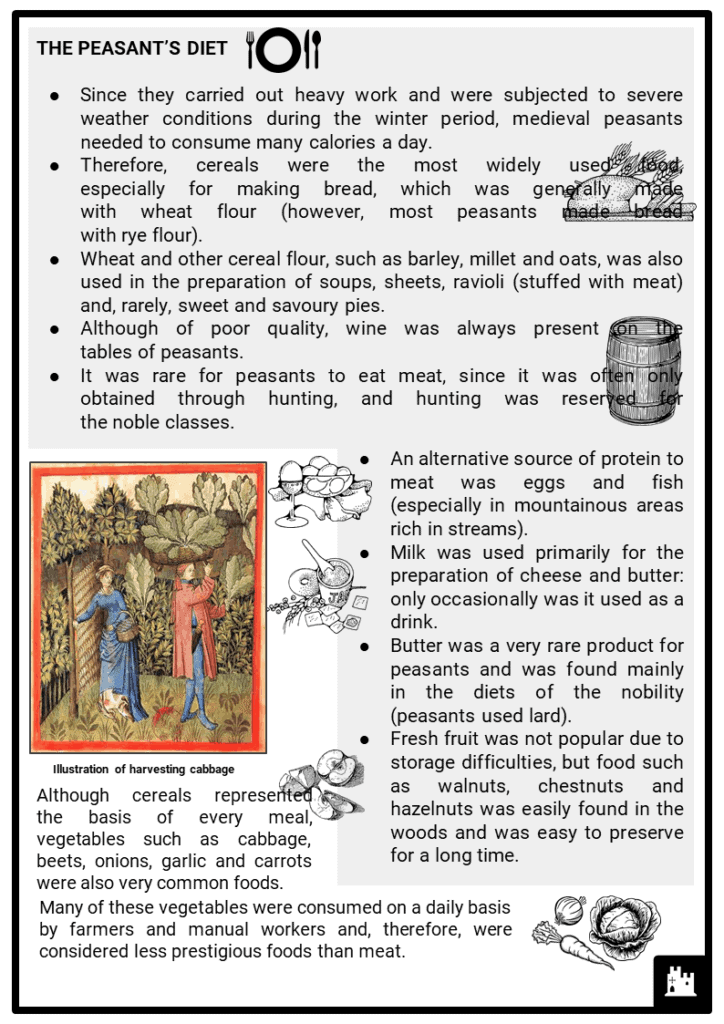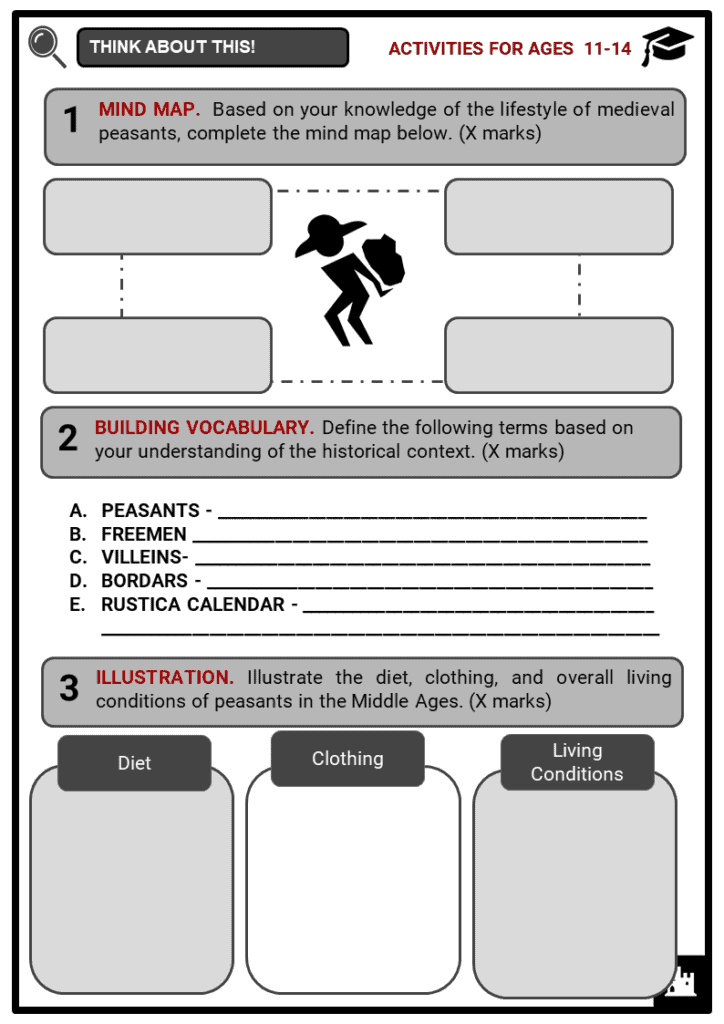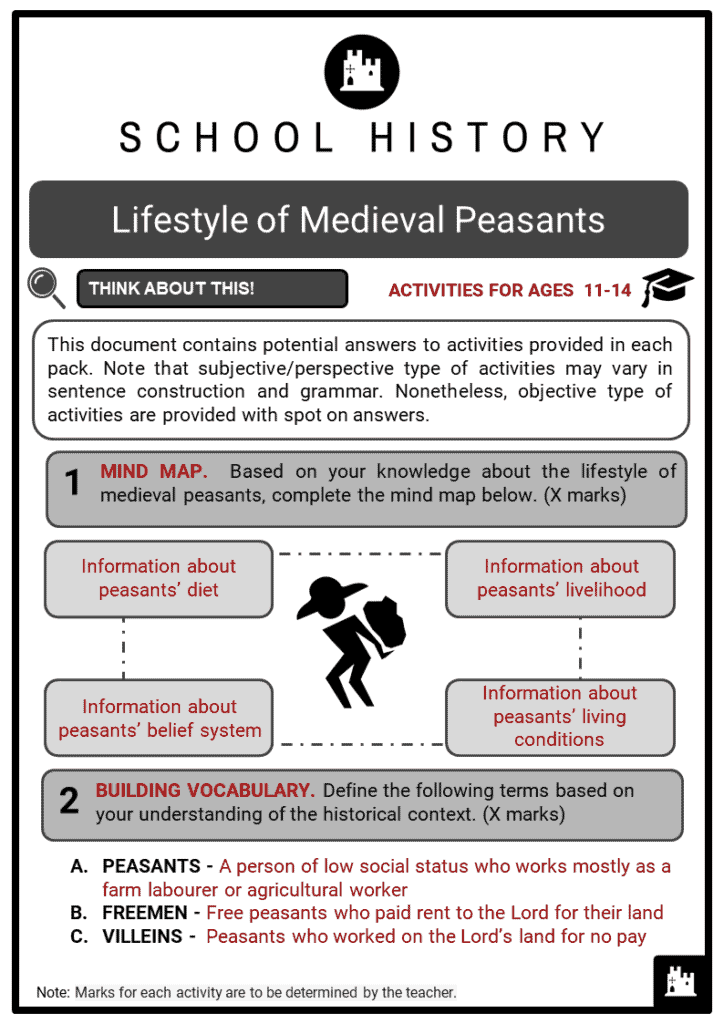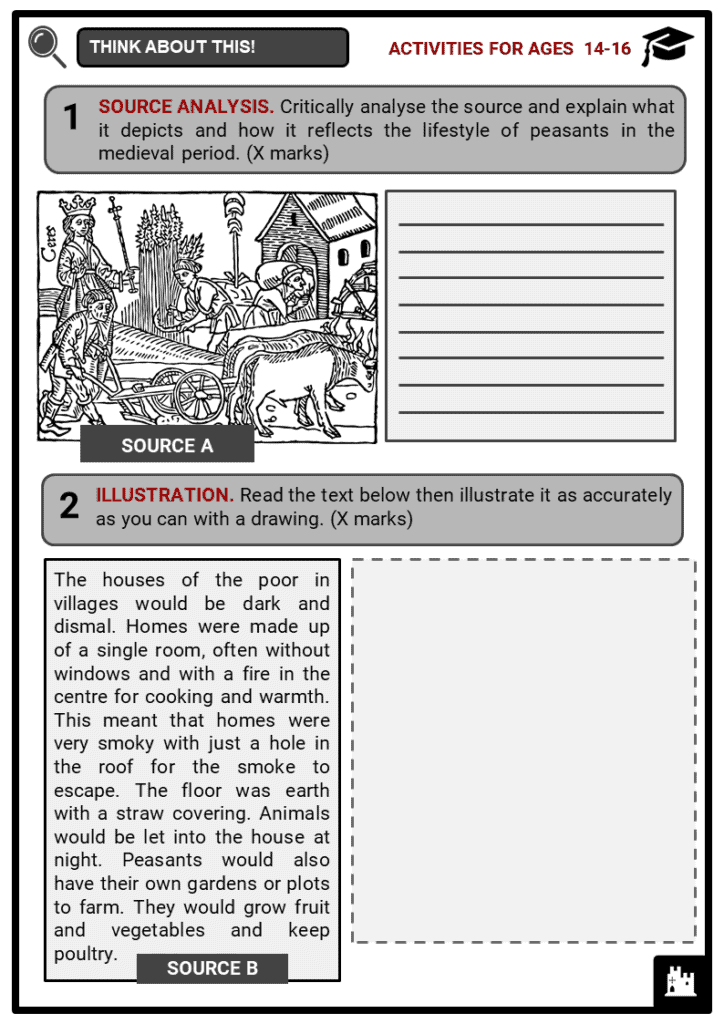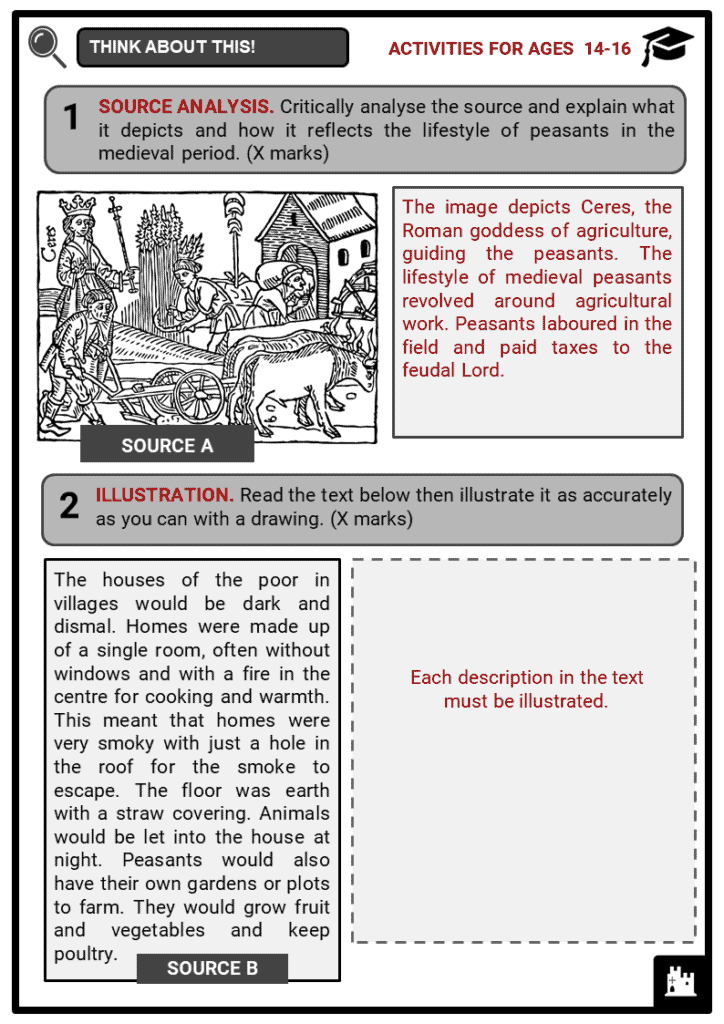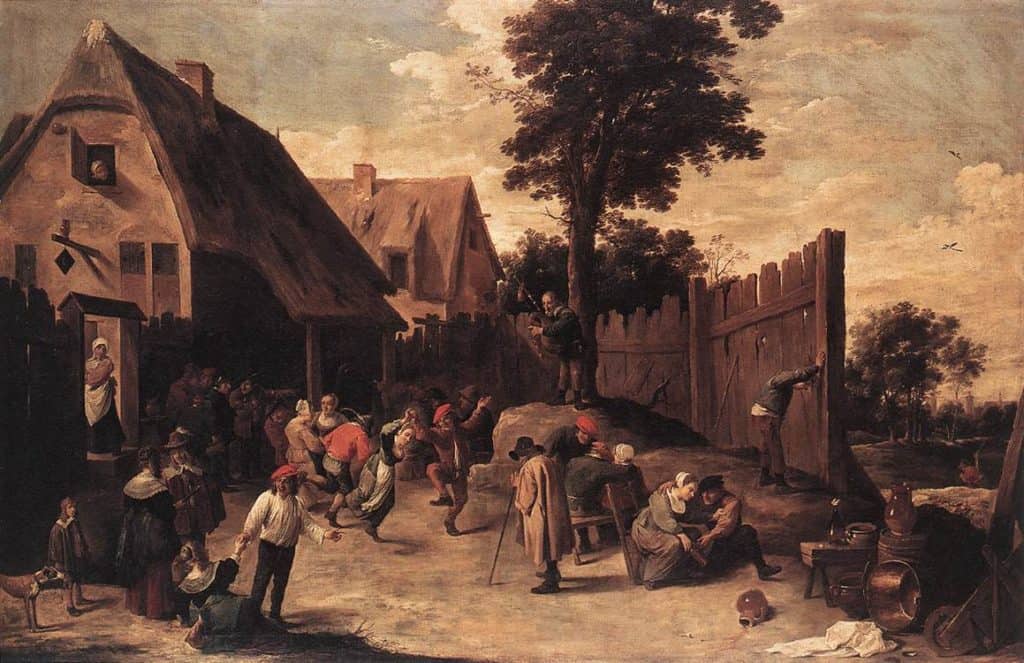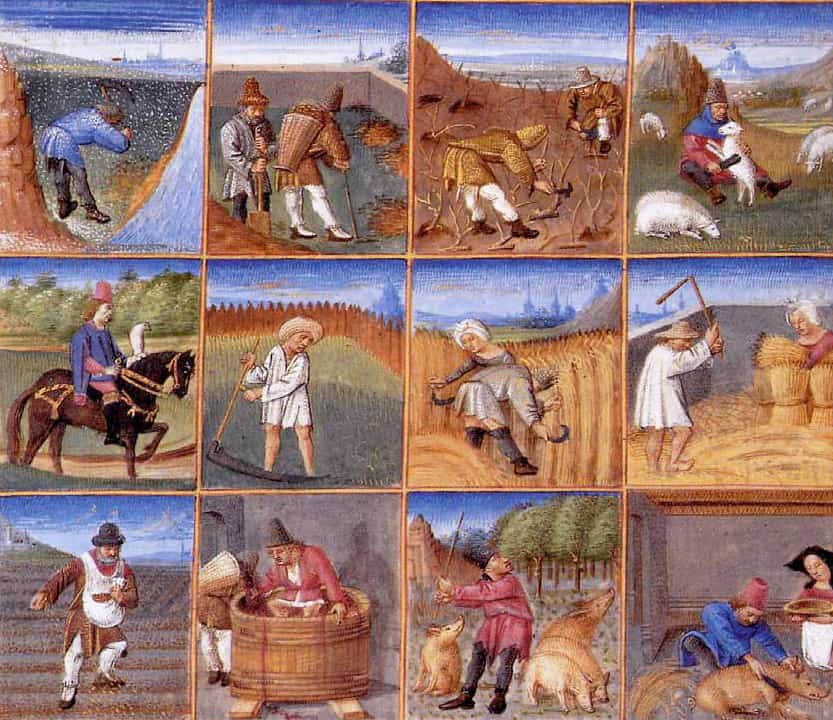Download Lifestyle of Medieval Peasants Worksheets
Do you want to save dozens of hours in time? Get your evenings and weekends back? Be able to teach Lifestyle of Medieval Peasants to your students?
Our worksheet bundle includes a fact file and printable worksheets and student activities. Perfect for both the classroom and homeschooling!
Table of Contents
Add a header to begin generating the table of contents
Summary
- Common food consumed by peasants in the Middle Ages
- Living conditions and typical clothing of peasants
- Taxes, restrictions and obligations of peasants to their Lords
- Belief system and convictions of peasants
- Agricultural work carried out by peasants
Key Facts And Information
Let’s find out more about Lifestyle of Medieval Peasants!
- Peasants in the Middle Ages were in a relationship of submission with the owner of the land or with the Lord who offered them a degree of protection and work in exchange for a contribution. In most cases, the contributions they needed to offer to the Lord consisted of a part of the harvest. Peasants were not free men and, most of the time, they depended on a Lord.
- Land in the village was controlled by the Lord of the Manor and the peasants who farmed it were tenant farmers - they did not own the land they worked.
- Most farmers were poor and lived miserably. The tools they used to cultivate the land were not very efficient. The use of fertilisers was very limited by the number of livestock. As a consequence, harvests were often low. Women worked more than men. They helped in the field as well as doing housework, which consisted of caring for the children, preparing meals and taking care of the farmyard.
The Peasant’s Diet
- Since they carried out heavy work and were subjected to severe weather conditions during the winter period, medieval peasants needed to consume many calories a day.
- Therefore, cereals were the most widely used food, especially for making bread, which was generally made with wheat flour (however, most peasants made bread with rye flour).
- Wheat and other cereal flour, such as barley, millet and oats, was also used in the preparation of soups, sheets, ravioli (stuffed with meat) and, rarely, sweet and savoury pies.
- Although of poor quality, wine was always present on the tables of peasants.
- It was rare for peasants to eat meat, since it was often only obtained through hunting, and hunting was reserved for the noble classes.
- An alternative source of protein to meat was eggs and fish (especially in mountainous areas rich in streams).
- Milk was used primarily for the preparation of cheese and butter: only occasionally was it used as a drink.
- Butter was a very rare product for peasants and was found mainly in the diets of the nobility (peasants used lard).
- Fresh fruit was not popular due to storage difficulties, but food such as walnuts, chestnuts and hazelnuts was easily found in the woods and was easy to preserve for a long time.
- Although cereals represented the basis of every meal, vegetables such as cabbage, beets, onions, garlic and carrots were also very common foods.
- Many of these vegetables were consumed on a daily basis by farmers and manual workers and, therefore, were considered less prestigious foods than meat.
Peasants’ Living Conditions And Clothing
- The peasants’ homes were simple. Since houses made out of stone were expensive and, therefore, rare, houses made out of wood or clay mixed with straw were much more common amongst the peasant class.
- People and animals lived under the same roof, especially during the winter.
- Their homes had a room where meals were consumed and where the family met. The oven was placed outside, while another building was used as a warehouse or a stable.
- All the buildings were characterised by dirt floors covered with straw and did not always have windows.
- Peasants were subject to many taxes, restrictions, and obligations towards their Lord.
- For example, they were required to pay a tax in order to fish.
- Around 97% of English people in 1066 were peasants. There were several different types of peasants:
- Freemen - free peasants who paid rent to the Lord for their land.
- Villeins - villeins worked on the Lord’s land for no pay. They had no freedom and could not leave the village without permission.
- They were granted some land to farm for themselves.
- Bordars and cottars - they were poorer than villeins and they were given less land by the Lord.
- Slaves - about 10% of the population in 1066. They had no freedom and no land.
- Moreover, in some periods of the year, they were obliged to work for their Lords without being paid (such duty was called corvées).
- The life of the peasants was often very hard and they fell victim to brigands and raids as their Lords were often fighting against other Lords or on the king’s campaigns.
- Sanitary conditions were very bad, which attracted parasites, lice, fleas and mites.
- Due to poor nutrition, diseases such as leprosy, malaria, and hyperthyroidism were endemic.
- In an age of recurrent epidemics and disease, and with the presence of doctors rare in the countryside, mortality was high.
Typical Clothing
- Clothes were grey or dark in colour.
- Usually, farmers had a work outfit and a casual outfit. The same garment was also reused by turning it into clothes for children.
- Women dressed wearing a shirt or a low-cut sleeveless robe, a skirt, cloak, veil, stockings and shoes (often wooden clogs). Women were engaged in various housework activities such as caring for the children, spinning and weaving, or taking care of farm animals.
Peasants’ Belief System
- In rural communities, saints were invoked for their thaumaturgical abilities.
- In the countryside, people believed in the powers of witches. They were often just women who knew about herbal remedies that dated back to the pre-Christian past, and knew the recipes for dealing with fertility, contraception and abortion, and healing people and animals in the communities where they lived.
- Since superstition was also commonplace, witchcraft and the cult for Diana – goddess of the woods and the wild world – certainly played an important role in the lives of rural peasants. Sanctuaries in her honour were built in outlying places.
- It was believed that witches had the gift of metamorphosis and that they could transform into cats – the animal associated with the devil.
- Others were convinced that they could turn into werewolves that wandered at night in search of prey.
- Among the most deeply-rooted convictions was the belief that these women had a certain power over the elements of nature and that, with simple gestures, they could generate storms, hail and lightning; they could also make animals sterile, women infertile and men impotent.
- The ‘witch’ stereotype was created when the Church started condemning rural traditions from the second half of the 14th century, which set off witch hunts. As a consequence, the Middle Ages was characterised by progressive marginalisation of the peasant world.
Peasants’ Jobs And Communal Lands
- In the early Middle Ages’ literature, peasants were depicted as superstitious pagans: they were regarded as socially dangerous, miserable, illiterate, ignorant thieves with rough customs.
- The farmers’ jobs were dictated by the natural calendar and consisted of ploughing, sowing, pruning, harvesting of fruits (apples, pomegranates, grapes, mulberries etc.) and cereals (wheat and rye), pressing, production of wine and oil, wheat threshing and weeding.
- There also existed numerous migrant peasants who worked in the countryside and gathered sheep’s wool. Such activity soon became a major industry in Europe with the breeding of different types of sheep.
- Peasants worked hard throughout the year, performing different tasks depending on the month and season.
- Thanks to the innovations and the continuous activity of the Benedictine monks, the peasant world saw some new introductions. These included new crops that came from distant lands, new cultivation techniques and new means that alleviated the workload, such as the ax, double-bladed forceps (to eradicate roots), the sickle with a short handle, the triangular harrow, a rigid collar attached to a horse,
the long-handle sickle, and the triple-blade ax. - The situation of peasants in the Middle Ages worsened in times of poor or no harvest. This could be due to raids, famine or natural disasters.
- Dating back to the 15th century, the Rustica calendar represented the primary agricultural work that peasants had to carry out each month.
- In essence, peasants worked hard during the day and lived in accordance with the rhythm of the sun: their tasks were performed from sunrise to sunset. The work was much lighter at certain times of the year: in winter, the cold, snow, freezing ground and short duration of solar illumination allowed them to stay safe in their homes. This period of the year was an ideal time for them to reorganise and maintain their tools.
- Peasants did not work on Sundays. Instead, they went to the village to carry out their religious practices and meet their friends.
- Once the peasants had harvested their land, the owner had to allow animals and other peasants to come and graze. This allowed landless peasants to feed small livestock (goats and sheep). Moreover, the excrements deposited by the animals enriched the soil. There also existed common land, which was generally not cultivated. Such land could be used by several peasants if the need arose.
Image sources:
[2.] https://upload.wikimedia.org/wikipedia/commons/1/1b/Crescenzi_calendar.jpg


